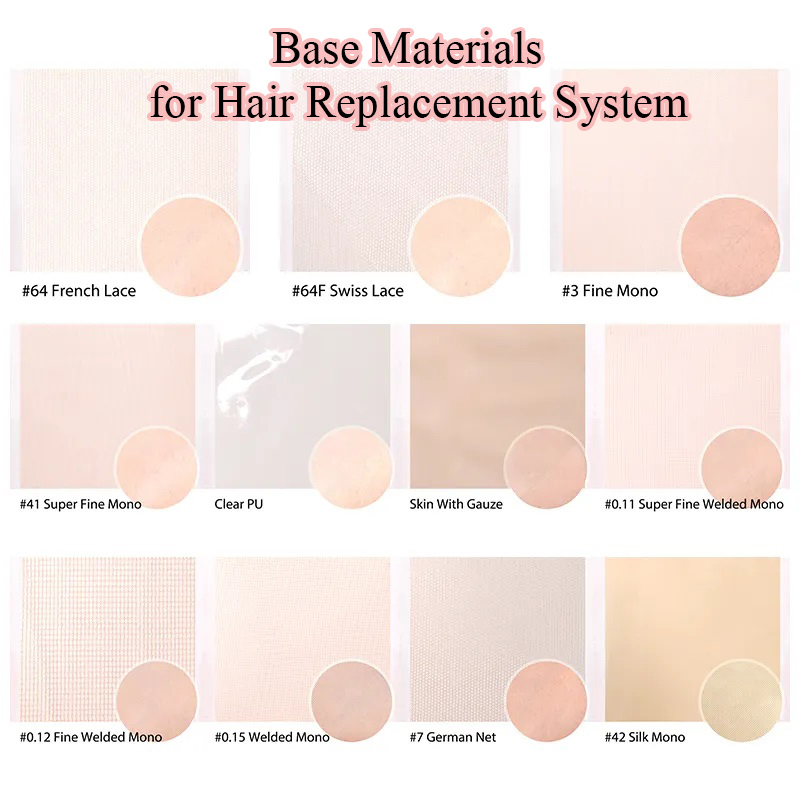In the second of our blogs on different wig base materials, we’ll look at polyurethane or PU bases and discuss their various properties so you’ll be able to make the correct recommendations to your customers.
We’ll begin by looking at transparent skin base materials. Transparent skin is 100% poly i.e. no other materials so that’s why it’s transparent.
0.03mm Ultra-thin Skin
Ultra-thin skin is the thinnest of our skin materials: it’s just 0.03mm in thickness. It’s a very light material and is so thin that it will just blend in seamlessly with your scalp. Since it’s such a thin material, we can only do V-looped hair on it. Other ventilation methods are simply not possible with ultra-thin skin toupees. The maximum density of ultra-thin skin can hold is medium-light. Being so thin, it also has other limitations. It can’t hold hair longer than 14” and critically, as far as your customers are concerned, ultra-thin skin base pieces cannot be expected to last longer than one month.

0.06mm Transparent Skin
0.06mm transparent skin is also very light and very natural. For thin skin with a thickness of 0.06mm or above, we can knot hair and we normally do single split knots. However, sometimes we do single flat knots on the back and sides to get a flat effect in those areas. A flat effect here is important as it means the hair on the back and sides of the hair system will lay down flat enough to blend well with the wearer’s hair.
There are three reasons why we don’t do either double split knots or double flat knots on 0.06mm clear PU. First of all, these two types of knots are bigger and more noticeable than single knots. Secondly, we must brush a layer of poly on the underside of all clear PU bases to seal the hair. So even though single split knots and single flat knots are weaker than double knots, after brushing on a layer of poly, the hair will be well sealed and will not easily loosen. Finally, there is no net on a clear PU base, just poly. So, if we used double split knots or double flat knots, we would have to pull the hair twice and it would be very easy to break the clear PU base.
Any hair density is possible with skin hair system bases that are 0.06mm in thickness or more. Just be aware that the heavier the density, the thicker the base needs to be.
0.08mm Transparent Skin
For skin bases that are 0.08mm in thickness or more, we can do normal injected hair and when the thickness is over 0.12mm, lift injected hair is also possible.
NOW, let’s look at another kind of PU which is stronger than transparent PU. This kind of PU is not just poly: it’s poly combined with other materials like mono, gauze, etc.
PU Coating/NPU
PU coating or NPU is made by adding one layer of lace or mono to a layer of skin so it is very strong. It’s normally just used on the edge of poly hair replacement systems to strengthen them. It’s thicker and not so natural, unlike transparent skin. We normally do single split knots or single flat knots on PU coating. However, since there is one layer of lace or mono in PU coating, it can hold double split knots or double flat knots that clients sometimes ask for.

PU with Gauze
This is thin gauze with a thin layer of poly on top of it. Gauze strengthens the base. PU with gauze can be made very thin (down to just 0.08mm). It can be made to cover the whole base or it can just be used as the edge of the base. It’s more natural than PU coating. We normally do single split knots or single flat knots on PU with gauze but since there is one layer of gauze in it, we can do double split knots or double flat knots if that’s what the client wants. PU with gauze can take any density.

Injected Silicone
A silicone base is very squishy so it feels much like real human skin. Better yet, we do inject hair on silicone skin wigs so the base material has a very realistic look. We can do injected hair – and only injected hair – on silicone. Since silicone is so soft, it will tear when we pull hair to make a knot. Your customers need to know that silicone bases are very thick but this thickness gives silicone units an advantage in that they can hold any type of hair density.
Anti-slip Silicone
Anti-slip silicone is very rough. It can’t be used on its own to make a base because it’s so soft and tears so easily. Instead, we brush it onto the base material that is used at the front, back or sides to stop the base from slipping and to help the base stay securely on the wearer’s head. We can’t knot hair directly onto silicone because silicone will break even from very light pulling. We also can’t use tape on silicone because if we did it would just fall off.
That concludes our blogs on hair system bases. If you haven’t read our blog on lace and mono base materials then you can do so here but in the meantime, if you have any questions about wig base materials or anything else, please feel welcome to email . At VietWig we believe we can offer you the very best in not only hair system products but also the very best support for your business thanks to our many years of experience and extensive knowledge of the toupee industry.




